You are using an out of date browser. It may not display this or other websites correctly.
You should upgrade or use an alternative browser.
You should upgrade or use an alternative browser.
Spindle moulder cutter question
- Thread starter RogerS
- Start date

Help Support UKworkshop.co.uk:
This site may earn a commission from merchant affiliate
links, including eBay, Amazon, and others.
RogerS
Established Member
Scrit":zrn941kc said:Ah, so what we used to write up as an "RTFM Failure", then? :lol:
Scrit
Wot manual?
Roger , ive just tried the omas blocks and they have cut a perfect rebate 20mm x 15mm in Iroko ( known for it's chipping ) One thing that does bother me is they don't stop spinning when the brake kicks in . Other than that it seems to got rid of the problem .
Right i'm off to change me pants and have a stiff drink :shock:
Right i'm off to change me pants and have a stiff drink :shock:
When T&G or tenoning disc sets are made up for spindle moulders it is common to use discs with oversize bores (40mm on 30mm and 1-1/4in arbor machines) and mount them on a high top hat adaptor, spaced out, then locked down with a C-ring at the top. That is to ensure that there's enough clamping force that the cutters won't move. If they're still spinning either they're not locked down tightly enough or your brake hasn't been adjusted to accommodate the weight of the toolingJFC":m3cl6tbw said:One thing that does bother me is they don't stop spinning when the brake kicks in.
The cutters you were using have scribers on them which would account for the cleaner cuttiing as the fibres are sheared before being hogged away.
Scrit
ProShop
Established Member
JFC":3qn45an1 said:Roger One thing that does bother me is they don't stop spinning when the brake kicks in . Other than that it seems to got rid of the problem .
Right i'm off to change me pants and have a stiff drink :shock:
JFC,
Are you saying the spindle has stopped and the disc is still spinning ?.
Be careful if it is as the spindle shaft and the cutter bore will heat up very quickly and make it extremely difficult to remove, I've seen them literally welded together in the past :shock: . As Scrit says make sure there clamped up well.
RogerS
Established Member
John...it's JFC who's spinning :wink:
No the spindle is spinning also . I've just been on the phone to Scrit and we think it's the brake but i will reset the whole thing in the morning and check .
Other than that i am amazed with the cut it has given , it has left a face edge of 20mm one side with no chips and a face of 0.72mm after the rebate with no chips :shock: (hammer)
Other than that i am amazed with the cut it has given , it has left a face edge of 20mm one side with no chips and a face of 0.72mm after the rebate with no chips :shock: (hammer)
This is a general problem with many DC injection brakes. They are set-up to stop a given weight in less than the mandatory maximum time, but spindle moulders can carry widely varying cutter weights. A 78mm diam. x 40mm high ally Euro profile block weighs 400 to 500 gm, a 100mm diam. x 40mm high steel Euro profile block weighs in at 1100 to 1200 gm (sans cutters), my 170mm diam. x 40mm high vari-angle chamfer block (in ally) is a svelte 1300 gm but the 190mm diameter panel raising block I sometimes use is a hefty 2.8kg without knives. Set the machine up to brake the small ally block and it mat allow the panel raiser to spin on (less of a problem with a spindle moulder as gravity will keep the cutters on the spindle, but still a potential contact injury hazard) - go the other way and set the brake up to cope specifically with the panel raiser and it may stop so abruptly when rumnning the small block that damage might occur.......... Great system, although having said that it's not normally too much of a problem :roll:JFC":1h45t7y7 said:No the spindle is spinning also . I've just been on the phone to Scrit and we think it's the brake but i will reset the whole thing in the morning and check .
Scrit
ProShop
Established Member
Sorry RogerRoger Sinden":d87wlqlf said:John...it's JFC who's spinning :wink:
ProShop
Established Member
JFC":36cxy0rr said:No the spindle is spinning also . I've just been on the phone to Scrit and we think it's the brake but i will reset the whole thing in the morning and check .
Other than that i am amazed with the cut it has given , it has left a face edge of 20mm one side with no chips and a face of 0.72mm after the rebate with no chips :shock: (hammer)
Phew, thats a relief
Jason
As I said I would here are the images of one of my tenoning sets. A bit cruddy, but that's what you get for workiung nasty 'orrible pine! As you can see this set is built-up on a top hat with all the spacers between the discs and locked with a C-nut (i.e. a nut which is locked using a C-spanner):
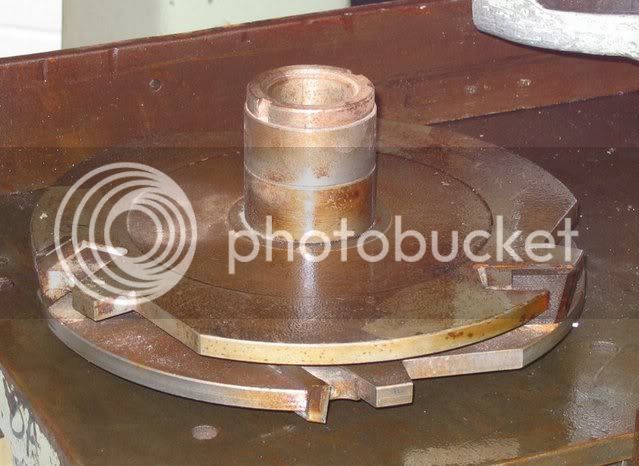
Close ups of the two scribing knife sets:
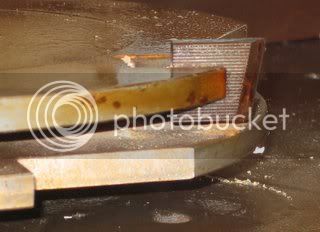
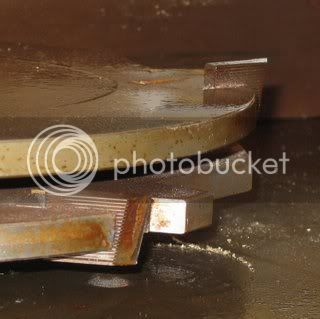
The tenon is formed between two horizontal axis cutter blocks then the scribed faces are undercut by the discs. On a spindle the whole action is performed in a single action so the cutters will blunt much quicker. Here is the underside of the set showing a spacer on top of the top hat:
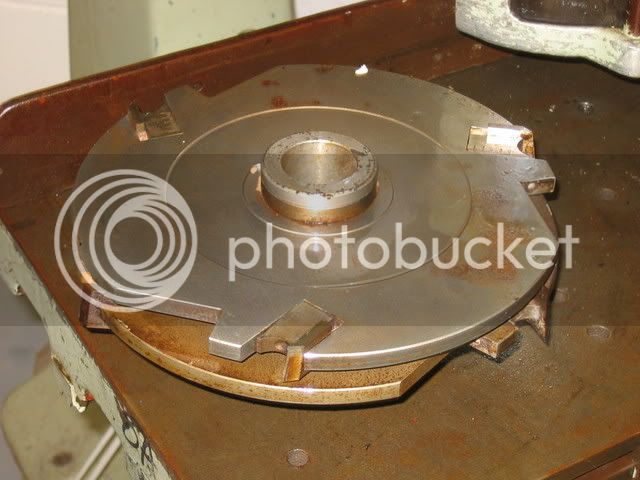
But locking all the cutters onto an auxillary top hat there are less surfaces to potentially slip and cause the spinning you experienced. As your tooling is 30mm bore and the sahft of your spindle is 1in (25.4mm) you could easily adopt a similar approach. This set-up weighs about 5 to 6kg and requires around 4HP (3-phase) to spin it.
And before anyone says it this is non-limiter tooling (but they don't have to be because the machine they are used on has pneumatic clamping and automatic feed operation making it exempt from the limiter requirement). With such large discs (these are circa 300mm diameter) it is necessary to have limiter tooling and clamp down work firmly into the sliding carraige/tenoning plate if running on a spindle moulder or manual feed tenoner. Not to do so is inviting the maching to pick up the work and eject it, tout suite
As far as rebates go, this is about the best block I've ever used:
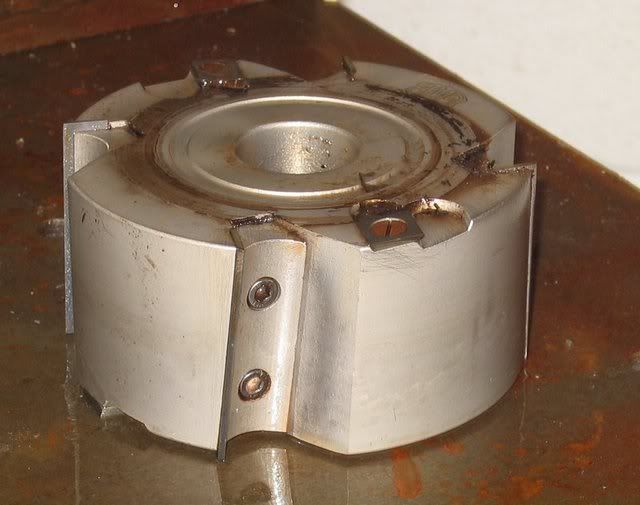
Four cutters all angled for a shear cut (thin disposable solid carbide), two nickers top and bottom. Runs rings round the cheaper blocks - ultra smooth cut, fast feed, no break-out at all - brilliant! About the only thing wrong with it is that it isn't recesses to run through tenons, but that would be a £30 to £35 job for the local engineers.
Scrit
As I said I would here are the images of one of my tenoning sets. A bit cruddy, but that's what you get for workiung nasty 'orrible pine! As you can see this set is built-up on a top hat with all the spacers between the discs and locked with a C-nut (i.e. a nut which is locked using a C-spanner):

Close ups of the two scribing knife sets:


The tenon is formed between two horizontal axis cutter blocks then the scribed faces are undercut by the discs. On a spindle the whole action is performed in a single action so the cutters will blunt much quicker. Here is the underside of the set showing a spacer on top of the top hat:

But locking all the cutters onto an auxillary top hat there are less surfaces to potentially slip and cause the spinning you experienced. As your tooling is 30mm bore and the sahft of your spindle is 1in (25.4mm) you could easily adopt a similar approach. This set-up weighs about 5 to 6kg and requires around 4HP (3-phase) to spin it.
And before anyone says it this is non-limiter tooling (but they don't have to be because the machine they are used on has pneumatic clamping and automatic feed operation making it exempt from the limiter requirement). With such large discs (these are circa 300mm diameter) it is necessary to have limiter tooling and clamp down work firmly into the sliding carraige/tenoning plate if running on a spindle moulder or manual feed tenoner. Not to do so is inviting the maching to pick up the work and eject it, tout suite
As far as rebates go, this is about the best block I've ever used:

Four cutters all angled for a shear cut (thin disposable solid carbide), two nickers top and bottom. Runs rings round the cheaper blocks - ultra smooth cut, fast feed, no break-out at all - brilliant! About the only thing wrong with it is that it isn't recesses to run through tenons, but that would be a £30 to £35 job for the local engineers.
Scrit
A
Anonymous
Guest
just bought "The Woodworkers Bible" by Alf Martensson. It contains the best and most interesting stuff on spindle moulding I've seen, including making your own cutters.
Much of it dated in terms of the regs, but how you get Martensson's versatility and also reg compliance is another question, well worth asking.
Essential reading for all spindlers.
cheers
Jacob
PS Does anyone happen to know the whereabouts of Alf M? Mrs Grimsdale also wants to know cos she used to work for him many years ago.
Much of it dated in terms of the regs, but how you get Martensson's versatility and also reg compliance is another question, well worth asking.
Essential reading for all spindlers.
cheers
Jacob
PS Does anyone happen to know the whereabouts of Alf M? Mrs Grimsdale also wants to know cos she used to work for him many years ago.
He used to run Woodstock in London, didn't he? But that was a good 20 to 25 years agoMr_Grimsdale":1ilub8cg said:PS Does anyone happen to know the whereabouts of Alf M? Mrs Grimsdale also wants to know cos she used to work for him many years ago.
Scrit
Jacob,
Get a copy of the Spindle Molder Handbook by Eric Stephenson (Stobart Davis) just about the best book on Spindle Molding. even got bits in about a French Head - Good old days.
Shows you how to develop out cutters ect and how to grind them freehand just like we did when I was kid in the shop.
Get a copy of the Spindle Molder Handbook by Eric Stephenson (Stobart Davis) just about the best book on Spindle Molding. even got bits in about a French Head - Good old days.
Shows you how to develop out cutters ect and how to grind them freehand just like we did when I was kid in the shop.
A
Anonymous
Guest
Yes got it. Good book too - but he can make things seem harder than they really are. The Martensson book somehow gives a more encouraging picture and has more photos. Best to have both books.Duncan":3lyft1hb said:Jacob,
Get a copy of the Spindle Molder Handbook by Eric Stephenson (Stobart Davis) just about the best book on Spindle Molding. even got bits in about a French Head - Good old days.
Shows you how to develop out cutters ect and how to grind them freehand just like we did when I was kid in the shop.
cheers
Jacob
Just out of interest I dug out my old and well-thumbed copy of Martensson's book (got the spelling right this time  ) and took a look at the section on spindle moulding. It's 14 pages long, shows lots of tooling which is unsafe and/or illegal in today's context and which can no longer be purchased (e.g. slotted collars, old-style Whitehill blocks, French cutters, square blocks, non-limiter brazed tooling, etc) and some of which (French cutters and square blocks) would even have been questionable in 1979 when the book was first published. Still, an interesting trip down memory lane......
) and took a look at the section on spindle moulding. It's 14 pages long, shows lots of tooling which is unsafe and/or illegal in today's context and which can no longer be purchased (e.g. slotted collars, old-style Whitehill blocks, French cutters, square blocks, non-limiter brazed tooling, etc) and some of which (French cutters and square blocks) would even have been questionable in 1979 when the book was first published. Still, an interesting trip down memory lane......
I'd get hold of the book for other reasons, though, as it is a mine of information, especially on options for starting a workshop with just power tools, and some of the examples of workmanship by people like Martin Grierson, Hans Wegner, John Makepiece, Alan Peters and others are truly inspiriational (even if the reproduction of the photos isn't the best ). It's just that the bits on spindle moulding and to a lesser extent other machinery is now very out of date and need to be viewed with a somewhat wary eye.
). It's just that the bits on spindle moulding and to a lesser extent other machinery is now very out of date and need to be viewed with a somewhat wary eye.
Scrit
I'd get hold of the book for other reasons, though, as it is a mine of information, especially on options for starting a workshop with just power tools, and some of the examples of workmanship by people like Martin Grierson, Hans Wegner, John Makepiece, Alan Peters and others are truly inspiriational (even if the reproduction of the photos isn't the best
Scrit
A
Anonymous
Guest
Yebbut as I said
cheers
Jacob
So how can we have the amazing versatility which was available not so long ago, and stay safe?Much of it dated in terms of the regs, but how you get Martensson's versatility and also reg compliance is another question, well worth asking.
cheers
Jacob
Jacob
Actually, having not read the book for years I was surprised just how out of date it had become. When I started French cutters were just starting to be phased out - now whilst I like the versatility and the low cost of French cutters I was never enamoured of the poor safety record or short life of the French cutter. Some of the stuff which has gone, like the square block and slotted collars I'll shed no tears over. They were just downright dangerous in their day, and people knew they were for many years before the axe fell.
A lot of what has happened in the last 30 years, such as improved fence designs, cutterblocks which can't throw cutters, the widespread acceptance of the power feeder, etc have been positive changes, I feel. The versatility you talk about is still there - it is possible to have a cutterblock which meets current limiter legislation whilst not requiring the making of a limiter cutter set (it's a British invention called the Armadillo block). Unfortunately this all comes at the cost of having to invest in a profile grinder (£3,000 and upwards new) and the Armadillo ring system (another £300 at least), although I can't understand why it is that nobody has managed to produce a really low-cost profile grinder for smaller workshops yet. Maybe it will happen one day.
Scrit
Actually, having not read the book for years I was surprised just how out of date it had become. When I started French cutters were just starting to be phased out - now whilst I like the versatility and the low cost of French cutters I was never enamoured of the poor safety record or short life of the French cutter. Some of the stuff which has gone, like the square block and slotted collars I'll shed no tears over. They were just downright dangerous in their day, and people knew they were for many years before the axe fell.
A lot of what has happened in the last 30 years, such as improved fence designs, cutterblocks which can't throw cutters, the widespread acceptance of the power feeder, etc have been positive changes, I feel. The versatility you talk about is still there - it is possible to have a cutterblock which meets current limiter legislation whilst not requiring the making of a limiter cutter set (it's a British invention called the Armadillo block). Unfortunately this all comes at the cost of having to invest in a profile grinder (£3,000 and upwards new) and the Armadillo ring system (another £300 at least), although I can't understand why it is that nobody has managed to produce a really low-cost profile grinder for smaller workshops yet. Maybe it will happen one day.
Scrit
Similar threads
- Replies
- 4
- Views
- 651
- Replies
- 4
- Views
- 649



